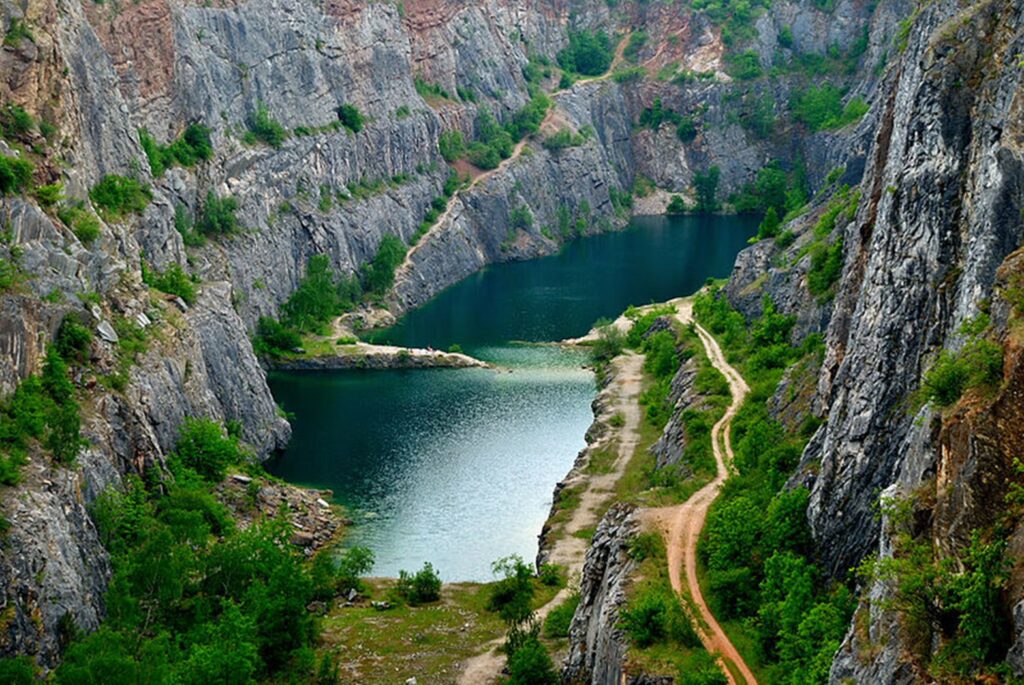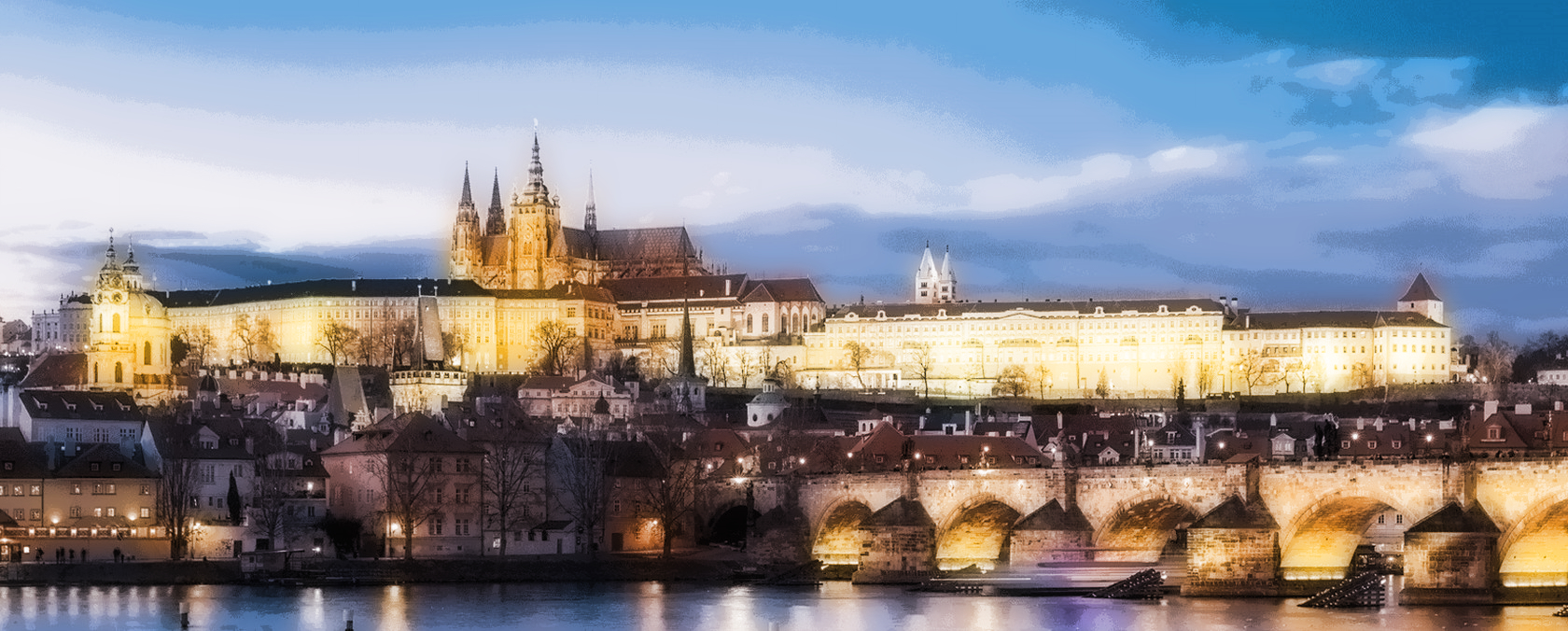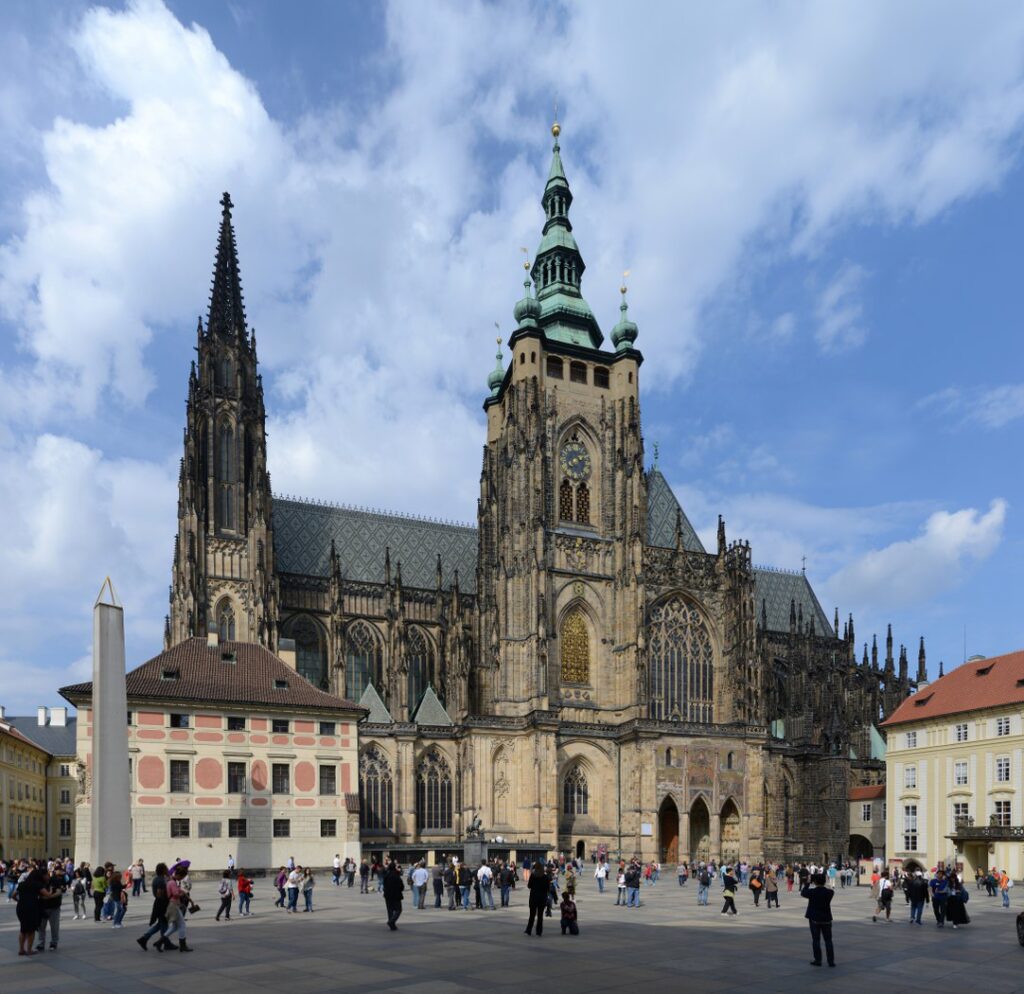Prague's architectural, cultural, and natural heritage
UNESCO protects the historical centre of Prague
Prague is an essential urban monument reservation. The historic core, 866 hectares in size, encompasses the unique city ensemble of the Prague Castle and Hradčany, Malá Strana (Lesser Side) including Karlův most (Charles Bridge), Staré Město (Old Town) with Josefov (the preserved section of the former Jewish town), Nové Město (New Town), Vyšehrad and each of the monuments within these areas. It was included on the UNESCO List in 1992.
Each part of the capital city of the Czech Lands – the Lesser Town, the Castle District, the Old and New Towns, was developed from the 10th century onwards. Prague Castle, the Cathedral of St. Vitus and Charles Bridge, many churches and palaces form a magnificent architectural, artistic and spiritual ensemble.
Prague Castle is a castle complex in Prague, Czech Republic, built in the 9th century. Now it is the official office of the President of the Czech Republic. The castle used to be a seat of power for kings of Bohemia, Holy Roman emperors, and presidents of Czechoslovakia. The Bohemian Crown Jewels are kept within a hidden room inside it.
According to the Guinness Book of Records, Prague Castle is the largest ancient castle globally, occupying an area of almost 70,000 square metres, at about 570 metres in length and an average of about 130 metres wide. The castle is among Prague’s most visited tourist attractions, attracting over 1.8 million visitors annually.
A UNESCO World Heritage site consists of a large-scale composition of palaces and ecclesiastical buildings of various architectural styles, from Romanesque-style buildings from the 10th century to Gothic modifications of the 14th century.
The Metropolitan Cathedral of Saints Vitus, Wenceslaus and Adalbert is a Roman Catholic metropolitan cathedral in Prague, the seat of the Archbishop of Prague. Until 1997, the cathedral was dedicated only to Saint Vitus and is still commonly named only St. Vitus Cathedral.
While most European cathedrals were built inside the cities, the Prague Cathedral grew out of the town, high above it, in the middle of Prague Castle, which was the seat of the rulers and a kind of sacred district with several churches. There was the ancient Church of St. Mary, St. Peter’s Basilica. George, where the remains of St. Ludmila and the Church of All Saints were kept, during which Charles of Luxembourg established a new chapter.
It took 600 years to build this masterpiece. That is why the cathedral is a mixture of different styles. The gothic and New Gotic style is prevailing, but Roman and Barocco’s parts are also beautifully incorporated.
The three-nave Gothic cathedral of the French type forms the end with a wreath of chapels and a rich support system, from which a high choir protrudes. On the south side, the St. Wenceslas Chapel projects into the courtyard and the adjoining southern vestibule with the Golden Gate (named after the golden background of the Last Judgment mosaic), projecting in front of the south facade of the transept. Late Gothic spiral staircases adjoin the corners of both transepts. Adjacent to the south is a large tower, in the lower part Gothic, at 55 m, where the building was to change into an octagonal floor plan, followed by a Renaissance gallery and a Baroque dome. In the lower part of the tower, there is a stone memorial plaque from 1394, which describes the progress of the medieval building. In contrast to the original project, which included an asymmetrical north tower, the architects of the modern extension decided on a solution with two towers in the west facade. The western part is also lined on both sides by a wreath of chapels.

Old Town Square
The most significant square of historical Prague was founded in the 12th century and has witnessed many historical events. In addition to the Old Town Hall and the Church of Our Lady before Týn, the square is dominated by the Baroque Church of St Nicholas, the Rococo Kinský Palace, and the Gothic House at the Stone Bell, the monument to Jan Hus. On the square pavement are memorial stones marking the execution of 27 Czech lords in 1621 and the Prague meridian.
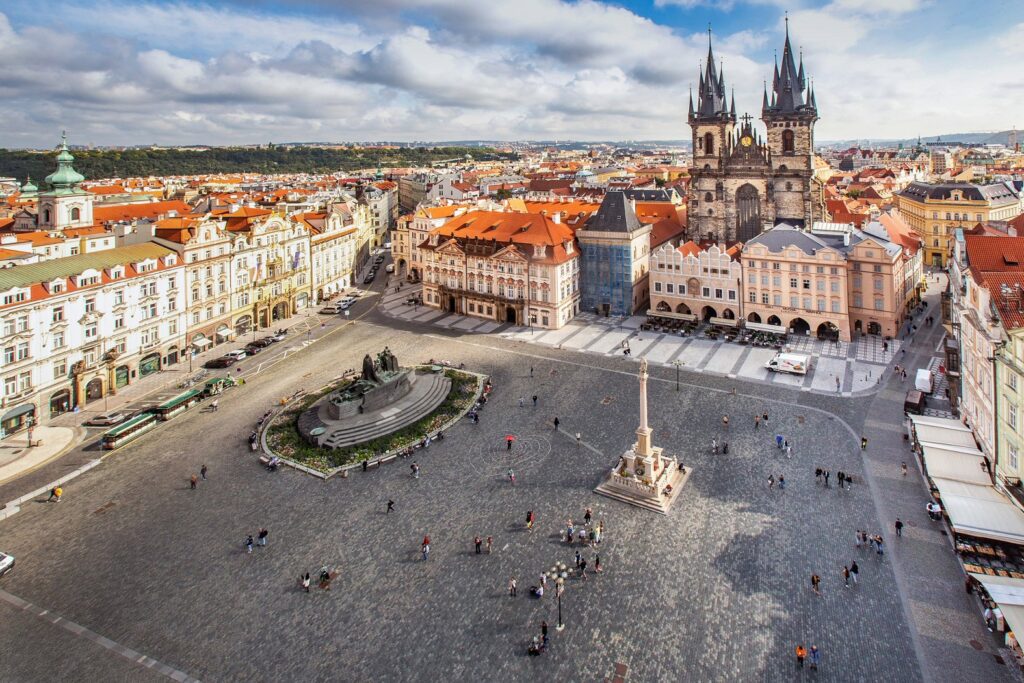
The Prague Astronomical Clock or Prague Orloj is a medieval astronomical clock attached to the Old Town Hall in Prague, the capital of the Czech Republic. The clock was first installed in 1410, making it the third-oldest astronomical clock globally and the oldest clock still in operation.
The Orloj is mounted on the southern wall of Old Town Hall in Old Town Square. The clock mechanism has three main components. The first is the astronomical dial, representing the position of the Sun and Moon in the sky and displaying various astronomical details. The second component is statues of various Catholic saints standing on either side of the clock; “The Walk of the Apostles”, an hourly show of moving Apostle figures and other sculptures, notably a figure of a skeleton representing Death, striking the time. And the last one is a calendar dial with medallions representing the months. According to local legend, the city will suffer if the clock is neglected and its good operation is in jeopardy; a ghost mounted on the clock was supposed to nod its head in confirmation. According to the legend, the only hope was represented by a boy born on New Year’s night.
The oldest part of the Orloj, the mechanical clock and astronomical dial, dates back to 1410 when it was created by clockmaker Mikuláš of Kadaň and Charles University professor of mathematics and astronomy Jan Šindel. The first recorded mention of the clock was on 9 October 1410.[4] Later, presumably around 1490, the calendar dial was added, and the clock facade was decorated with gothic sculptures.
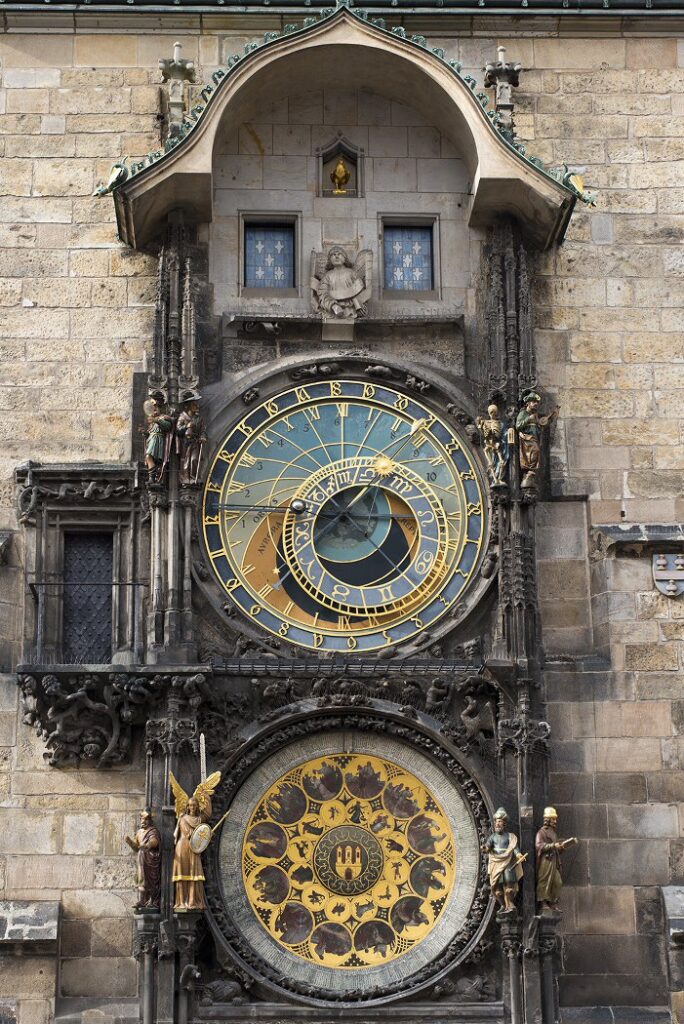
Formerly, it was believed that the Orloj was constructed in 1490 by clock master Jan Růže (also called Hanuš); this is now known to be a historic mistake. A legend, recounted by Alois Jirásek, has it that the clockmaker Hanuš was blinded on the order of the Prague Councillors so that he could not repeat his work; in turn, he disabled the clock, and no one was able to repair it for the next hundred years.
In 1552 it was repaired by Jan Táborský (1500–1572), the master clockmaker of Klokotská Hora and tells the time even now in 2022.
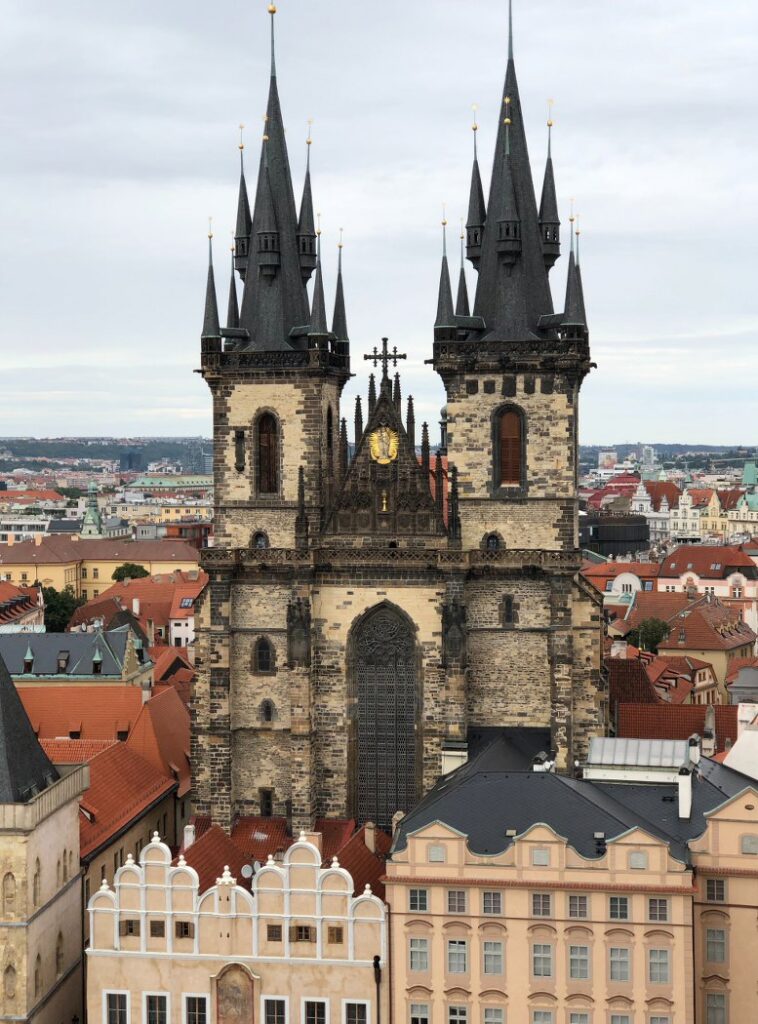
The Church of Mother of God before Týn, often translated as Church of Our Lady before Týn, is a Gothic church and a dominant feature of the Old Town of Prague, Czech Republic. It has been the main church of this part of the city since the 14th century. The church’s two towers are 80 m high, and eight smaller spires top each tower’s spire in two layers of four.
In the 11th century, the Old Town plaza area was occupied by a Romanesque church, which was built for foreign merchants coming to the nearby Týn Courtyard. It was replaced by an early Gothic Church of Our Lady before Týn in 1256. Construction of the present church began in the 14th century. The church was designed in the late Gothic style under the influence of Matthias of Arras and later Peter Parler.
The main entrance is located on the church’s western face. It is found through a narrow passage between the houses in front of the church.
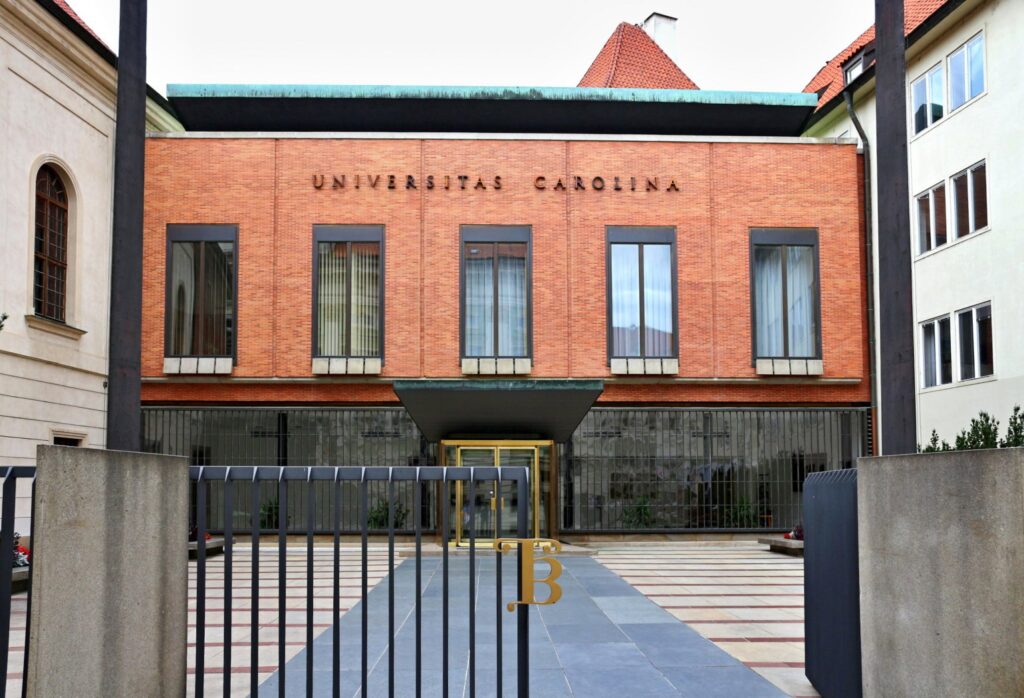
Charles University, also known as Charles University in Prague or the University of, is the oldest and largest university in the Czech Republic. It is one of the oldest universities in Europe in continuous operation. Today, the university consists of 17 faculties located in Prague, Hradec Králové, and Plzeň. Charles University belongs to the top three universities in Central and Eastern Europe. It is ranked around 200–300 in the world.
Charles University was founded in 1348 during the rule of King of Bohemia and Holy Roman Emperor Charles IV. It became the first Studium generale north of the Alps and east of Paris.
Modelled on universities in Bologna and Paris, it quickly gained international renown. It had four faculties: theology, liberal arts, law, and medicine.
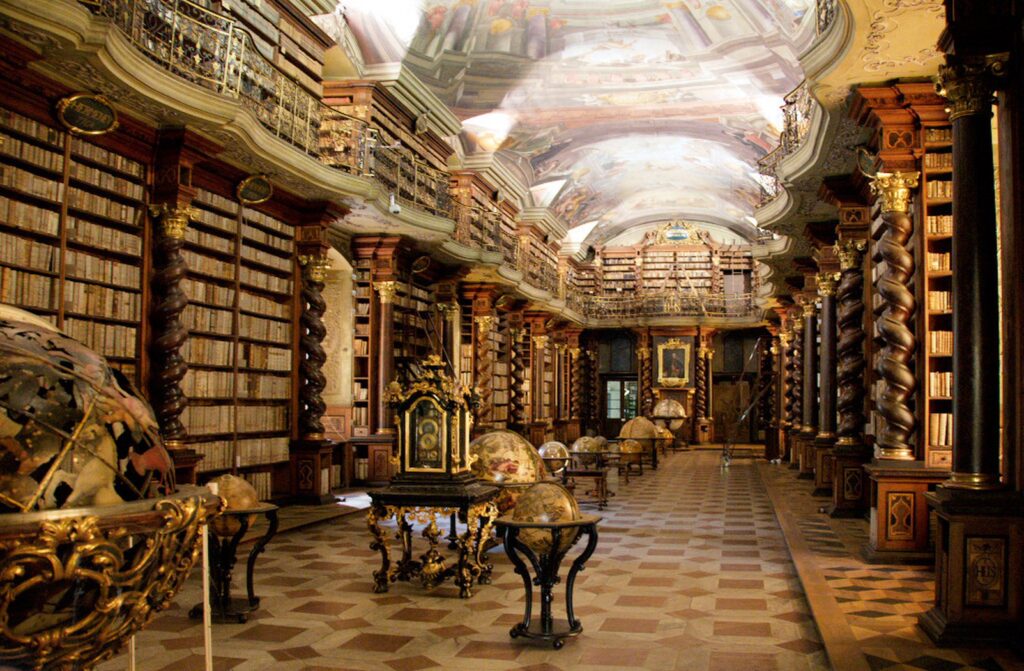
Today, Charles University consists of 17 faculties, based primarily in Prague, two houses in Hradec Králové and one in Plzeň.
Charles University does not have one joint campus. The academic facilities occupy many locations throughout Prague. The main historical building from the 14th century, called Carolinum, is situated in Prague’s Old Town and constitutes the university’s centre. It is the seat of the rector and the Academic Senate of Charles University. Carolinum is also the venue for official academic ceremonies such as matriculations or graduations.
Its academic publishing house is Karolinum Press, and the university also operates several museums. The Botanical Garden of Charles University, maintained by its Faculty of Science, is located in New Town.
Source: https://cuni.cz/UKEN-106.html
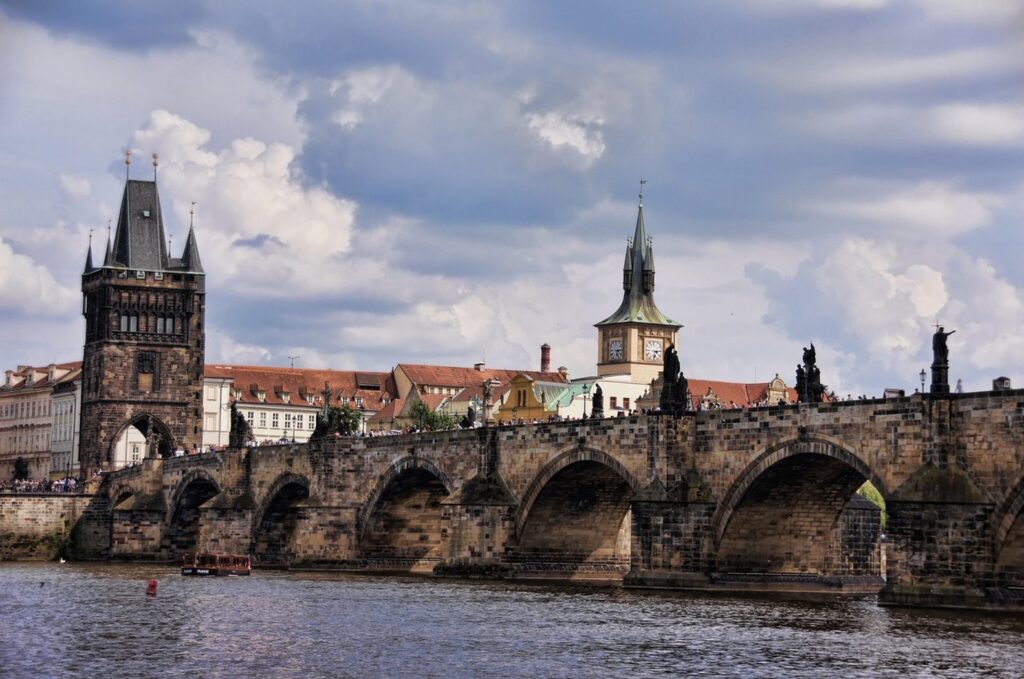
Charles Bridge is the oldest bridge still standing over the Vltava river in Prague and the second oldest bridge in the Czech Republic. Charles IV had it built in 1357 after the last bridge (“Judith Bridge”) had been destroyed by floods in 1342. The construction of the bridge was led by Peter Parler (“Petr Parléř” in Czech), the famous German-Czech architect, and it took almost half a century to finish it (It was completed in 1402). The bridge, formerly known as “Stone” or “Prague”, has only been called “Charles Bridge” since 1870. And until 1841, it was the only bridge over the Vltava River in Prague.
A 14th-century stone bridge connects Prague’s Old Town to the Malá Strana neighbourhood, flanked by Gothic Tower gateways on either side.Charles Bridge is 516 meters long, 9.5 meters wide, 13 meters high, and stands on 16 pillars. It’s also the part of the so-called Royal Route used to carry kings along their coronation procession from Old Town to the Prague Castle.
The bridge is lined with thirty statues of saints, including the martyred St John of Nepomuk. Based on various legends promising good luck, visitors have rubbed the plaques at the base of his star-crowned likeness
Charles Bridge is built of sandstone blocks, and many exciting legends surround its construction. According to one of those, the builders decided to strengthen the bridge by adding raw eggs into a mortar. Historians still have not come to any definitive agreement on whether it is true. But what is most likely a myth is another story. People said that there were not enough eggs in Prague, so people were bringing them from every corner of the land. And the inhabitants in one of the regions were afraid that the eggs would break during the transportation, so they sent them boiled – to the great amusement of the whole of Prague.
You can go to Charles Bridge anytime. There are no closing hours (it’s publicly open 24/7) and no entrance fee – it’s completely free. The bridge toll has not been collected for 200 years. Source: https://www.praguego.com/attractions/charles-bridge/
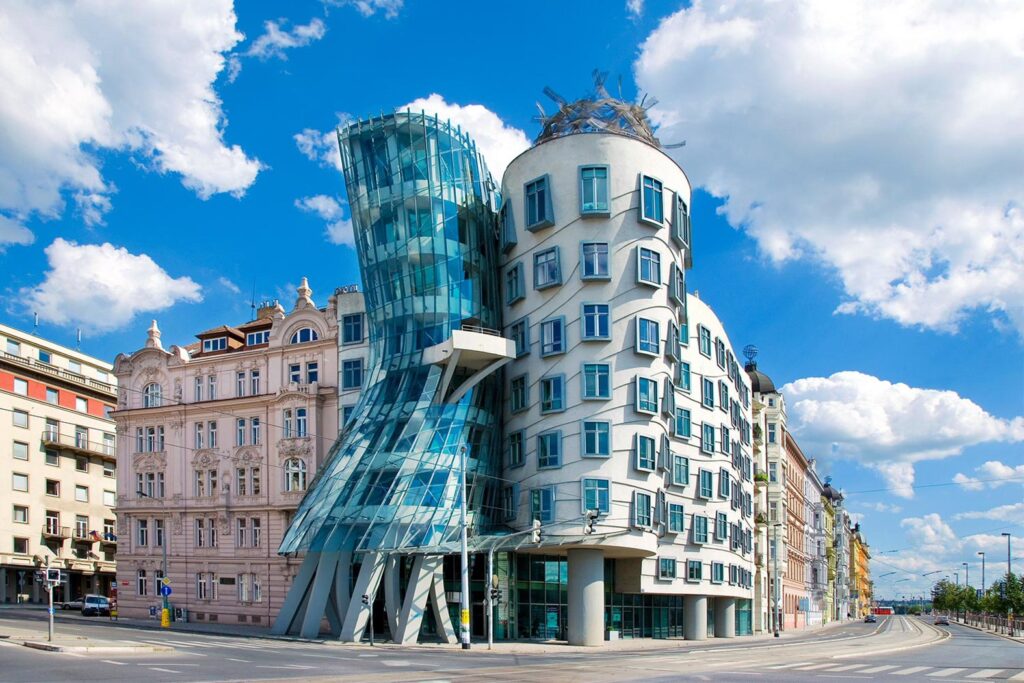
The Dancing House is one of the most charming Prague houses built at the end of the 20th century. It represents a man and a woman dancing together, and it is one of Prague’s most acclaimed modern buildings. You can see this great house at the Jirasek Square and Rasin Quay alongside the river Vltava.
A house originally occupied the site in the Neo-renaissance style from the end of the 19th century. That house was destroyed during the bombing in 1945, and its remains were finally removed in 1960. The space was empty for several decades then. Coincidentally, in the neighbouring house lived the former Czech Republic president Vaclav Havel, and he ordered an architectural study of the place from Croatian architect Vlado Milunic. Finally, the Dutch company Nationale Nederlanden bought the site in 1992 and decided to build an administrative centre there.
Vlado Milunic asked the famous Toronto architect and designer Frank O. Gehry to work on the project. Together they built a dynamically looking building that seems to be dancing on the quay. It represents two dancers, Fred Astair and Ginger Rogers – that’s why it’s also called “Ginger and Fred”. Ginger’s glass tower bends and clings to Fred’s concrete building, which has a metal cupola on the top, representing hair. The house is an example of deconstructivist architecture.
Critics of the building point out that it doesn’t fit into its surroundings, where various Art Noveau houses can be seen. Also, the unusual shape of the building is disputable. But after several years, it is regarded as one of the fascinating Prague buildings from the end of the previous century.
The Petřín Lookout Tower is a steel-framework tower 63.5 metres tall on Petřín Hill in Prague, built-in 1891. It resembles the Eiffel Tower and used to be an observation tower and a transmission tower. Today the building is a significant tourist attraction.
Petřín Lookout Tower is often described as a miniature version of the Eiffel Tower. Although, in contrast to the Eiffel Tower, Petřín Lookout Tower has an octagonal, not square, cross-section. Further, it does not stand, as does the Eiffel Tower, on four columns of lattice steel. The whole area under its legs is the entrance hall. A similarity between the Eiffel Tower and Petřín Lookout Tower is the design of the lowest cross beams in the form of round bones.
In 1889, members of the Club of Czech Tourists visited the world exposition in Paris and fell in love with the Eiffel Tower. They collected a sufficient amount of money, and in March 1891, the building of the tower started for the World’s Jubilee Exhibition. It was ready in only four months.
In 1953, a television broadcasting antenna was installed on Petřín Lookout Tower. It served as Prague’s television signal provider until the opening of the Žižkov Television Tower in late 1992.
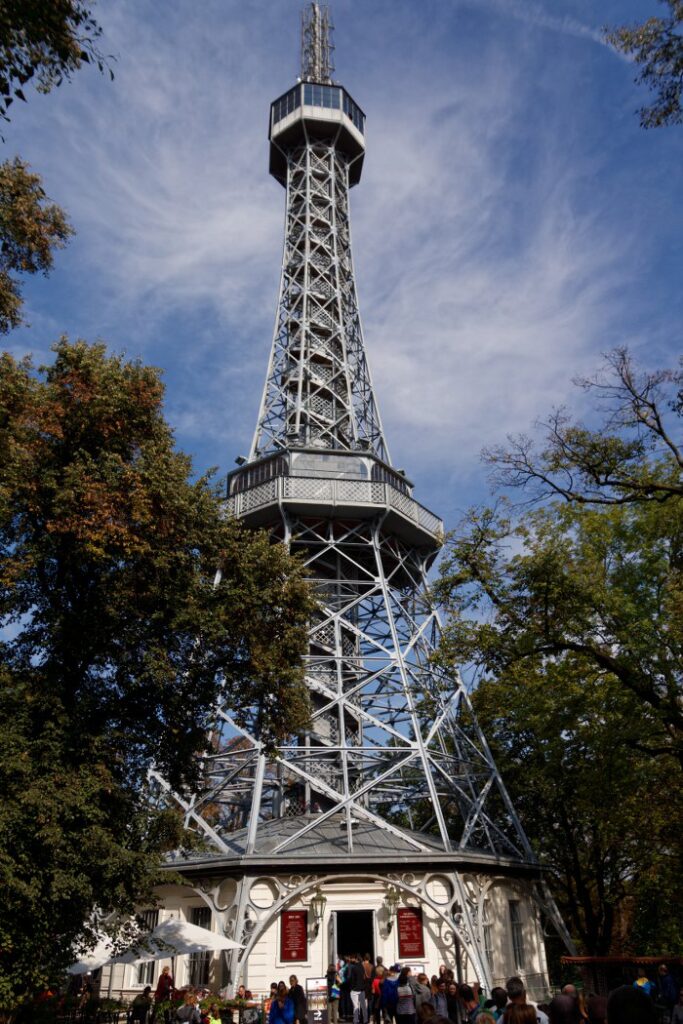

If you make your way around the Průhonice Park, you feel like walking through a work of art. You are not far off the mark. Thanks to the lifelong efforts of the park’s founder, Count Ernst Emanuel Silva-Tarouca, and his successors, the use of the space is balanced so that visitors feel relaxed and free from unwanted distractions.
Since 1885, when the park was founded, no other landscape architect has had 250 hectares of land at their disposal to design as they pleased, limited only by their ideas and plans. Nor is it usually that one architect would continue to care for their work for nearly 50 years. A. E. Silva-Tarouca created the last independent landscape park in the country and possibly worldwide. Today, the work he started is continued by the Průhonice Park Management, part of the Institute of Botany located here.
In 1885, the Count began to lay out his natural landscape park, rooted in the artistic representation of natural elements. He incorporated the rugged valley of the Botič river and its tributaries, the Dobřejovický and Zdiměřický streams. He combined original native trees with imported exotic species, for which the park often served as a gateway not only to Bohemia but to the whole of Europe. The masterfully chosen vistas form the basis of the park’s design and often surprise you in places you would not expect them. The Count juxtaposed clusters of trees and shrubs with meadows, ponds, and dead-end streams. He artfully used the way the trees change throughout the seasons. These elements form a diverse, elaborate, and harmonious whole.
In addition to its importance from an artistic and historical point of view, the park also has considerable dendrological value as a collection of native and exotic trees. It also is home to the Průhonice Botanical Garden with its unique collections of irises, peonies, daylilies, roses, and rhododendrons.
The Průhonice Park also includes a cone collection (the “dendrotheque”) assembled over several decades by Miroslav Kučera, a long-time employee of the Průhonice Park Management. Thanks to its 2,659 specimens, it is one of the three largest cone collections in the world. Originally a private collection, it is now owned by the Institute of Botany and is used for study purposes.
The Průhonice Park, the Průhonice Castle, is The Průhonice Castle, a UNESCO World Heritage Site and a National Cultural Monument.
Source: https://www.pruhonickypark.cz/en/about-park/
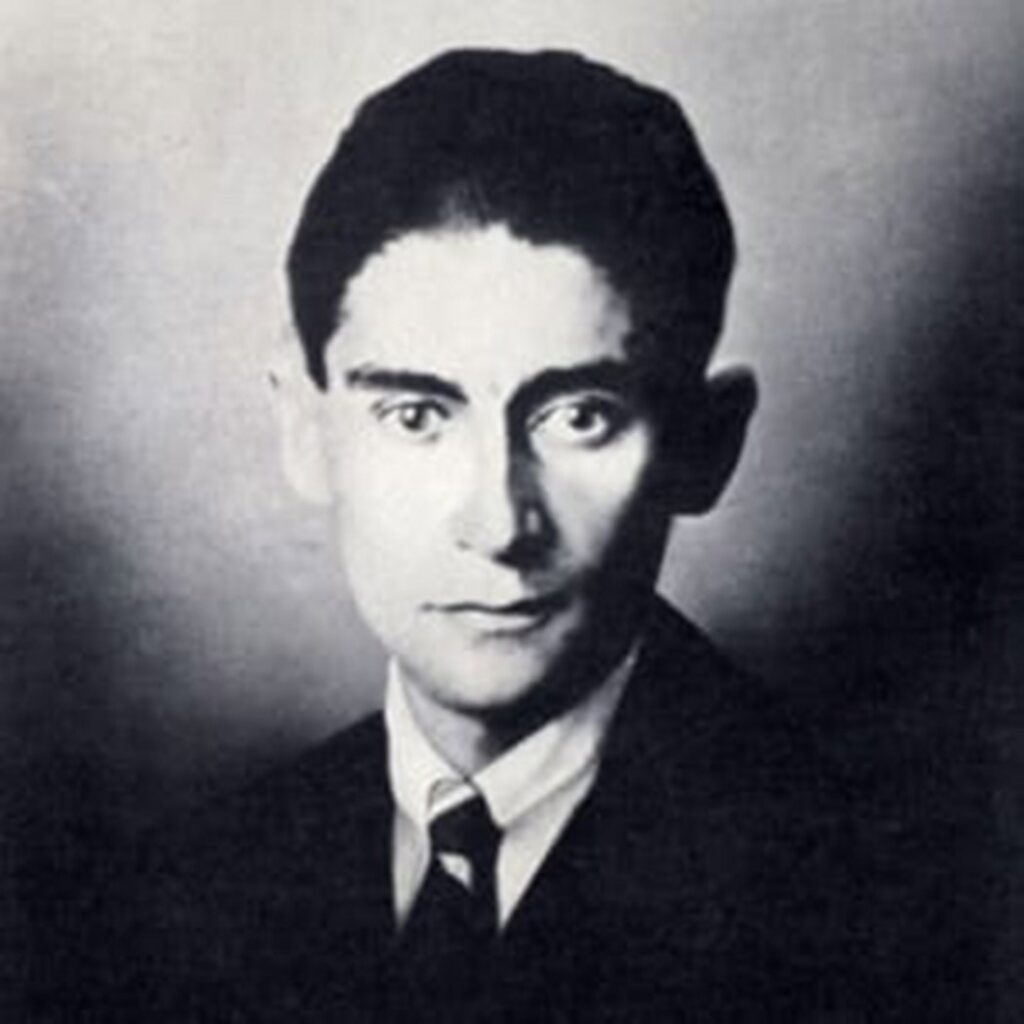
Author Franz Kafka grew up in an upper middle-class Jewish family. After studying law at the University of Prague, he worked in insurance and wrote in the evenings. In 1923, he moved to Berlin to focus on writing, but died of tuberculosis shortly after. His friend Max Brod published most of his work posthumously, such as Amerika and The Castle.
His most popular and best-selling short story, “The Metamorphosis,” was completed in 1912 and published in 1915. The story was written from Kafka’s third-floor room, which offered a direct view of the Vltava River and its toll bridge.
As the 1960s took shape and Eastern Europe was under the fist of bureaucratic Communist governments, Kafka’s writing resonated particularly strongly with readers. So alive and vibrant were the tales that Kafka spun about man and faceless organizations that a new term was introduced into the English lexicon: “Kafkaesque.”
The measure of Kafka’s appeal and value as a writer was quantified in 1988, when his handwritten manuscript of The Trial was sold at auction for $1.98 million, at that point the highest price ever paid for a modern manuscript.
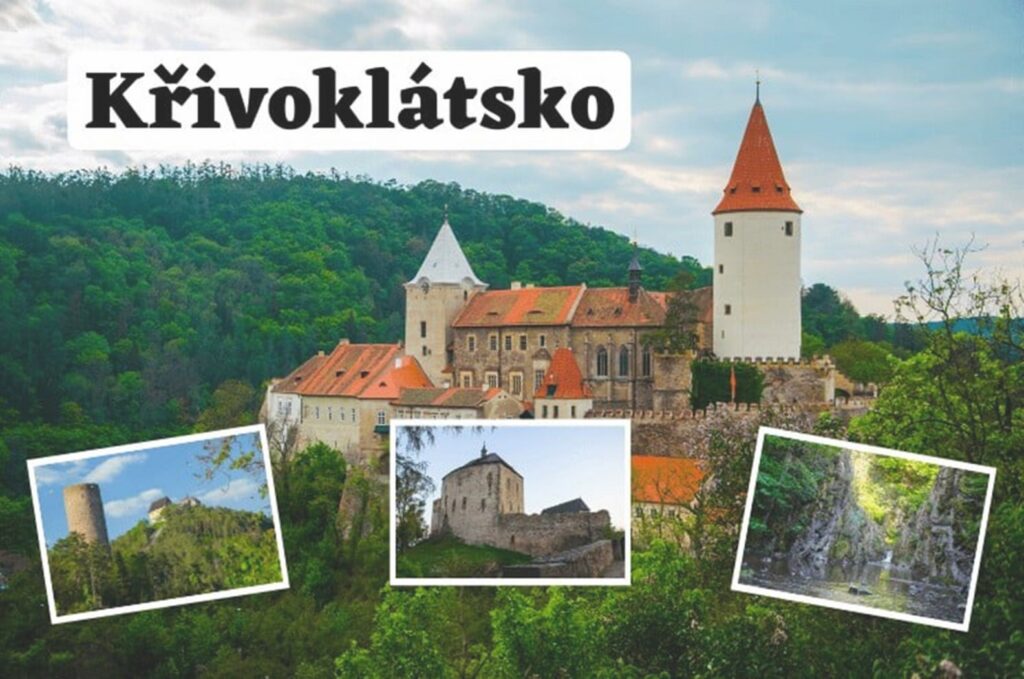
It is located in the village of Křivoklát, about 50 km west of Prague, at the foot of the Gothic castle of Křivoklát. The Křivoklátsko Protected Landscape Area is a region renowned for its extensive well-preserved forest areas around the middle reaches of the Berounka river.
